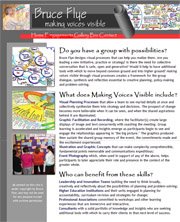The Institute for Cultural Affairs includes in its workshops the practice of Focused Conversation, a process for shared reflection that sets the stage for subsequent action. The idea is that each of us prefers one of four modes of thought: objective, reflective, interpretive or decisional. When you find yourself in a meeting that seems to be going all over the place, the odds are that all four of these voices are trying to play out simultaneously. The Focused Conversation offers a way of working through these different thought styles in sequence so that each can make its contribution for the benefit of the greater whole. I have used the process with results that range from the spectacular to the regretful. As the method as presented is verbally oriented, the potential for images is an ongoing question in my own mind.
 Recently I served as a graphic recorder for a planning workshop. As I had also been asked to facilitate a closing discussion, I chose the Focused Conversation method. With this particular group of university faculty and practicing professionals it was very difficult to hold them to the sequence, as their minds were clearly in an interpretive mode. They were polite and respectful, but I was not successful with the process as planned. Just before I turned the meeting back to the organizers I was asked to walk them through the graphic record. In just a minute or two, the ambience changed drastically, attaining the engagement through the graphic that I had sought through conversation. Afterwards, I realized I had not taken advantage of other lessons.
Recently I served as a graphic recorder for a planning workshop. As I had also been asked to facilitate a closing discussion, I chose the Focused Conversation method. With this particular group of university faculty and practicing professionals it was very difficult to hold them to the sequence, as their minds were clearly in an interpretive mode. They were polite and respectful, but I was not successful with the process as planned. Just before I turned the meeting back to the organizers I was asked to walk them through the graphic record. In just a minute or two, the ambience changed drastically, attaining the engagement through the graphic that I had sought through conversation. Afterwards, I realized I had not taken advantage of other lessons.
During the spring I worked with a graduate program on a strategic plan, and at one point I was asked to present the committee’s work to their faculty of about forty. This transition from the committee to the stakeholders is always a dicey proposition, and I decided to take a blended approach to the Focused Conversation. I briefly presented the planning to date, using a very large graphic around which our planning process had been built. At the end of my remarks, I put this big group through a brief mind-clearing exercise, and then presented the objective question that begins the process; however, rather than asking each of them to speak their response, I asked them all to come up and write it on the graphic itself. We then completed the conversation with them standing around the image and their notations. The resulting atmosphere created some insightful discussion, including a couple of ah-ha’s and – most importantly – the group’s decision that the committee should continue along its current path.

